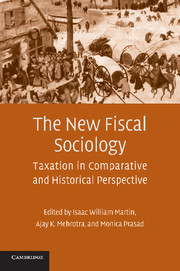Book contents
- Frontmatter
- Contents
- List of Contributors
- Acknowledgments
- Foreword
- 1 The Thunder of History: The Origins and Development of the New Fiscal Sociology
- PART ONE SOCIAL SOURCES OF TAXATION: AMERICAN TAX POLICY IN COMPARATIVE PERSPECTIVE
- PART TWO TAXPAYER CONSENT
- 6 The Politics of Demanding Sacrifice: Applying Insights from Fiscal Sociology to the Study of AIDS Policy and State Capacity
- 7 The End of the Strong State?: On the Evolution of Japanese Tax Policy
- 8 War and Taxation: When Does Patriotism Overcome the Free-Rider Impulse?
- 9 Liberty, Democracy, and Capacity: Lessons from the Early American Tax Regimes
- PART THREE THE SOCIAL CONSEQUENCES OF TAXATION
- References
- Index
7 - The End of the Strong State?: On the Evolution of Japanese Tax Policy
Published online by Cambridge University Press: 13 January 2010
- Frontmatter
- Contents
- List of Contributors
- Acknowledgments
- Foreword
- 1 The Thunder of History: The Origins and Development of the New Fiscal Sociology
- PART ONE SOCIAL SOURCES OF TAXATION: AMERICAN TAX POLICY IN COMPARATIVE PERSPECTIVE
- PART TWO TAXPAYER CONSENT
- 6 The Politics of Demanding Sacrifice: Applying Insights from Fiscal Sociology to the Study of AIDS Policy and State Capacity
- 7 The End of the Strong State?: On the Evolution of Japanese Tax Policy
- 8 War and Taxation: When Does Patriotism Overcome the Free-Rider Impulse?
- 9 Liberty, Democracy, and Capacity: Lessons from the Early American Tax Regimes
- PART THREE THE SOCIAL CONSEQUENCES OF TAXATION
- References
- Index
Summary
Japan has long been held up as a model of fiscal discipline and budget restraint. Indeed, Japan has held the remarkable distinction of being the country with the lowest budget deficits and the lowest levels of public spending of any of the rich Organisation for Economic Co-operation and Development (OECD) nations almost the entire postwar period. Even in the 1960s and 1970s, for example, when most other advanced capitalist democracies were building extensive welfare states, Japan continued to practice spending restraint while it was experiencing economic growth rates nearly double the OECD average. Many assumed that it was precisely the strength of state institutions (or the bureaucrats who populated them) that accounted for both the high levels of economic growth and the remarkable budgetary constraint experienced by this country (Borrus et al. 1982; Pempel 1979; Savage 2000; Thurow 1992). Indeed, Japan was sometimes held up as a premier example of a successful democratic “strong state” (Johnson 1982; Samuels 1994; Thurow 1992).
In the early twenty-first century, however, Japan's position looks altogether different. Not only has the country suffered more than a decade of poor economic performance, but in addition the budget has apparently grown out of control. In 2006, for example, the budget deficit was approximately 30 trillion yen – or 6 percent of Gross Domestic Product (GDP). Even more surprisingly, the total national debt has accumulated to 160 percent of GDP.
The following figures graphically demonstrate the extent to which Japan's fiscal situation has changed in the past thirty years (Figure 7.1) and how badly Japan has done in this regard when compared to other advanced capitalist nations (Figure 7.2).
- Type
- Chapter
- Information
- The New Fiscal SociologyTaxation in Comparative and Historical Perspective, pp. 119 - 137Publisher: Cambridge University PressPrint publication year: 2009
- 10
- Cited by

